
Kennedy Center Coup d'état: Trump, The Celebrate Freedom Concert and the state of the arts
- or - “Mama Said Knock You Out”
On December 27 of last year, the Associated Press ran a news story that was picked up by newspapers and websites around the country. It bore the headline: “Trump, in Washington, stays close to home” -- which detailed the near-total lack of engagement by President Donald Trump with the local Washington, D.C. social scene during his first year in office. The article compared Trump’s hermetic behavior to that of his predecessor, President Barack Obama, who throughout his eight years in office regularly left the White House residence to frequent local restaurants, schools, shops, performances, charity events, and sporting events. It’s a fairly good article by a veteran AP reporter. However, it contains one serious error.
In the opening paragraph, the journalist states that President Trump “hasn’t taken in a performance at the Kennedy Center” during his first year in office. This is grossly incorrect.
The Celebrate Freedom Concert
On July 1 of last year, President Trump visited the John F. Kennedy Center for the Performing Arts in Washington, D.C. to attend the Celebrate Freedom Concert. This concert featured performances from the First Baptist Church Dallas Choir & Orchestra. It was part of a larger event billed as the “Celebrate Freedom Rally” organized by Celebration Concert Tours International (a for-profit, Christian-themed, booking and management agency based in Tennessee) and the First Baptist Church of Dallas (led by Senior Pastor Dr. Robert Jeffress). The Celebrate Freedom Rally and Concert ran for over two hours and featured a mixture of both religious and patriotic songs, interspersed with quasi-religious political speeches from Tea Party Congressman Louie Gohmert (R-TX), Dr. Robert Jeffress, and President Donald Trump himself.
Designed and marketed to honor military veterans and current members of the United States Military, the Celebrate Freedom Rally often drifted into different terrain. It celebrated religious freedom while espousing fundamentalist Christian views and perspectives that demonize the role of government in the United States of America. The Celebrate Freedom Rally completely sold out the Kennedy Center with thousands in attendance, and a television audience of millions who watched live on July 1 via Daystar -- an evangelical Christian, broadcast television network. The entire event was then re-broadcast four times on July 4 via Daystar. Several weeks later, Dr. Jeffress’ Pathway to Victory website began mailing DVD copies of the Celebrate Freedom Rally to any who requested it via an online registration form.
The Celebrate Freedom Rally and Concert taking place inside the Kennedy Center for the Performing Arts represents a coup d'état of the cultural and artistic life of the United States. The July 1, 2017 event went largely unnoticed by American arts leaders. This is beyond astonishing. When it happened, the Celebrate Freedom Rally was barely reported on by American journalists -- to such an extent that now it cannot even be cited by the Associated Press (when Trump himself spoke at the event!). This is nothing short of remarkable and terrifying.
The Kennedy Center
It required nearly 33 years to realize the Kennedy Center -- from the first congressional resolution in 1938 calling for a “National Cultural Center” -- to passage of the National Cultural Center Act in 1958 by President Eisenhower -- to the delayed groundbreaking by President Johnson in 1964 -- until the first live performance was held there in September 1971. During that time, what would eventually be called “The Kennedy Center” faced many fundraising challenges to cover its construction costs. Ultimately, fundraising was aided only by the outpouring of grief following the assassination of President Kennedy; with Congress finally stepping in to cover $43 million of construction costs; supplemented by an additional $23 million in donations from corporations, foundations, and private individuals. President John F. Kennedy himself ( October 26, 1963 at Amherst College, MA ) -- working in coordination with his wife, Jackie, and Senator Claiborne Pell (D-RI) [ October 28 - November 2, 1963 in the US Senate ]-- is directly responsible for taking a vague concept like public funding of the arts -- one that had languished in fruitless speeches in Congress since the 1930s -- and helped to bring it into the mainstream; eventually becoming law with passage of the National Foundation on the Arts and the Humanities Act of 1965.
For those who may not recall -- because it has been a tumultuous year -- President Trump began his first term calling for the total elimination of the National Endowment for the Arts (NEA) and the National Endowment for the Humanities (NEH). While he was unsuccessful in 2017, it revealed President Trump’s desire to erase from American history a right which took decades to argue into existence -- that Americans can and should expect their government to adequately fund the arts and culture. President Kennedy is one of the key figures who helped establish the very same cultural rights President Trump now wishes to erase.That American arts leaders are unaware of what President Trump said and did during his first appearance at the Kennedy Center -- our national cultural center -- boggles the mind. That we are not interested in the art President Trump experienced -- specifically what music and songs were played (and by whom) during the Celebrate Freedom Rally -- represents an oversight of tragically epic proportions.
Even if the Celebrate Freedom Rally and Concert organized by Concert Tours International was a “rental event” not part of any official Kennedy Center artistic programming -- it still authenticates and legitimizes extremely dangerous viewpoints not only about the role and function of government, but the very nature of the arts in America. What transpires during the Celebrate Freedom Rally offers insights pointing towards an extremely dire future for the arts in this country; an increasingly minimized and tangential role for the arts that will further curtail the arts’ impact on American’s lives and hasten the arts’ descent into such irrelevance until it becomes merely a decorative accessory. That American arts leaders have taken virtually zero notice of the Celebrate Freedom Rally represents a cognitive failure on a bewildering scale -- made even more frightening because of the lack of foresight and imagination already demonstrated throughout the 2016 Presidential Election.
Why you should watch the Celebrate Freedom Rally
I would urge anyone still reading this essay to watch the Celebrate Freedom Rally and Concert in its entirety. Virtually the whole concert and interspersed speeches can be viewed simply by clicking the icon above. I know, I know -- I get it, trust me, I understand -- nearly two hours of patriotic music, religious hymns, and political speeches is not a pleasant thing to watch. Believe me, I wish I had better things to do with my time also. I take no pleasure in watching such things.
However, I believe there is a great deal to learn from such an exercise. It offers an opportunity to better comprehend what has actually been transpiring in the United States during the last few decades. It also provides clear insights to formulating a more effective response to combating it. To borrow and repeat a phrase I employ as a theatre director when I encounter difficult moments during a rehearsal process: “All the answers are already present in the room.” In the case of the Celebrate Freedom Rally and Concert -- all the questions and all the answers to them -- are already present inside the concert hall itself; as are the sources of our existing problems and the path towards more effective solutions. All that is required of us is to watch and listen.
I suspect we reached the limits of comedy and satire a long time ago; the same goes for activism and journalism.
A crucial aspect of whether this can be a helpful exercise or not -- boils down to how we choose to view the material. All too often, since Donald Trump first declared his candidacy for President, the starting point for people in the arts, the humanities, and the entertainment industry -- has been one of derision and ridicule. The intention of the viewer focused solely upon uncovering some outrageous moment, exchange, or reaction that can serve as ammunition for comedy and satire. In other instances, the starting point for the viewer has been outrage and disgust. This is completely valid, since a great deal of what President Trump utters during such events is beyond reprehensible. Entire “cottage industries” have cropped up during the last three years, rising in conjunction with the prominence of the Trump campaign and his successful first year in office. The mining for satirical material has provided enough fuel to power content on multiple comedy shows across several different seasons, channels, and platforms. The prospecting for outrage has unearthed enough raw energy to increase the operating budgets of non-profits across the country, and supply news programs in television and radio with enough talking points to debate in perpetuity.
Why repetition will not help us in stopping Trump
I propose that neither approach works. Neither was successful in stopping Donald Trump (and the forces around him) prior to Election Day 2016. Indeed, one could argue that both approaches -- derision and disgust -- blinded us. We obsessed with both emotions to such a degree they evolved into full-time occupations -- preventing us from seeing what was actually transpiring at the state and local level in the nation. The prospects of repeating and repeating this behavior for the next 2.5 years, does not seem like a viable option. Both approaches -- derision and disgust -- are too easy, too linear, and too simplistic to serve as starting points for viewing. They provide false comforts to us now. Each emotion lets us off the hook too easily.
While I am the first one to praise repetition as an effective dramatic device, repetition is not going to help us during a Trump administration. We’ve been here before with President Ronald Reagan in 1982 and with President George W. Bush in 2004. Each was the recipient of similar diets of ridicule and rage. (Someone please find Walter Mondale and John Kerry to ask them how all that played out for them.) In many respects, we are living in a grand “re-run” episode of sorts. Sadly, there exists no “easy button” to press on the remote control that will absolve us of our complicity in what transpired on Election Day 2016.

I suspect we reached the limits of comedy and satire a long time ago; the same goes for activism and journalism. Of course, many people still practice and participate in these things, but they have long since stopped being effective. This infinite supply of derision and disgust might fuel the ratings for Saturday Night Live -- or be responsible for increased revenue streams at The New York Times or The Washington Post -- but neither has done much to transform the solidified structures supporting Trump (and those who surround him). Call me crazy, but I’ve had enough one-dimensional Alec Baldwin impersonations of President Trump, and there’s only so many snarky Rachel Maddow diatribes a person can endure in one lifetime. The motivating factors behind both appears to be nothing more than derision and disgust; employed so vehemently and so incessantly during the last year -- that one might suggest it was an irrational attempt to cover up our guilt at the ignorance and blindness we displayed during the 2016 Election. Watching the July 1 Celebrate Freedom Rally and Concert through such a prism will not reveal any new knowledge or understanding; and it certainly won’t solve our problems. I propose we take off our knitted outrage hats and remove our disdain goggles -- take a deep breath -- and when we watch, try to practice a radical idea -- the demonstration of empathy.
It's time to try empathy
Empathy is the ability to understand the feelings of another person. It demonstrates a capacity to place oneself into another person’s frame of reference, to imagine the life experiences and conditions that have led another person to be who they are, or where they are, at this particular stage in their life. Now, I can already hear the grumbles and protests arising from people reading this essay -- how dare I suggest showing empathy to a crowded concert hall full of fervent Trump supporters? How can you suggest offering empathy to people who are not only willing to listen and tolerate a litany of divisive remarks from President Trump -- but who are actually entertained by his behavior? It’s a fair point. However, demonstrating empathy for others should not be equated with condoning their behavior; nor should any approval of Trump’s policies be inferred by raising this suggestion. At some point though -- after three long and relentless years of late-night talk-show hosts and cable news analysts incessantly pursuing a strategy of derision and disgust -- doesn’t some other avenue of inquiry warrant consideration?
This is all one grand “re-run” episode from the 1980s. Nothing more.
Who are these people in attendance at the Celebrate Freedom Rally and Concert? Where did they come from? Do they live in Washington, D.C.? Or across the Potomac River in neighboring Virginia? If not, what states did they travel from? How much did they pay to travel? Is it their first time at the Kennedy Center? How did they hear about the concert? Do they regularly attend concerts? Do they attend other arts events? If so, what kind of arts? Who are the musicians and singers that make up the First Baptist Church Dallas Choir & Orchestra? What have their artistic careers been like in an under-funded arts system like the one we have in the United States? Do they actually enjoy the music they are playing? Or do they have other musical interests? Are they ardent believers? Or is this simply the only decent paying gig they can find in Texas? The same goes for the videographers, the lighting and sound designers, the tour managers, the stage managers, and the broadcast team working behind the scenes. Is this all just a day job for them? Maybe the only steady and decent paying job they can find these days? Does the financial need play some role in their political views? In their religious views? Do they have any views? Or are they just going along with the flow?
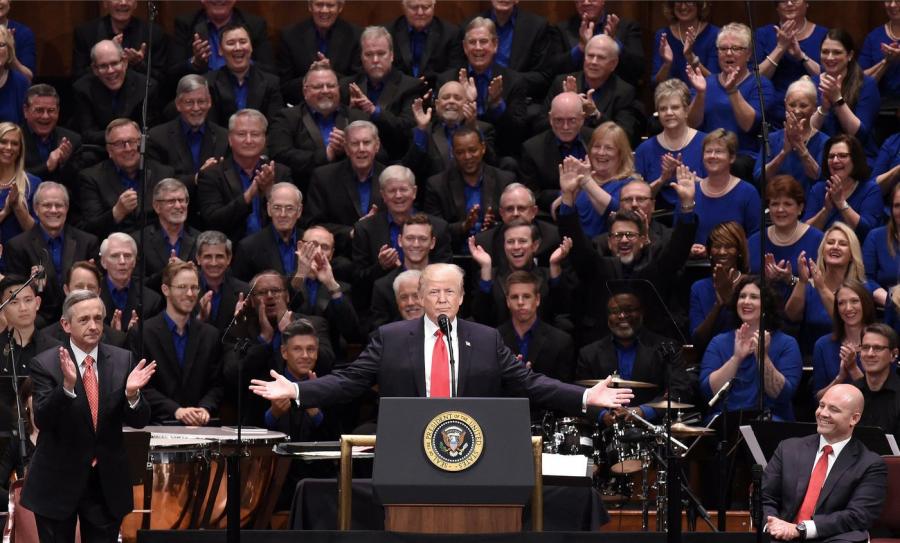
Last summer, I watched the Celebrate Freedom Rally and Concert online (during rehearsals for THE AЯTS project in New York). I was struck by the diversity in the audience, choir, and orchestra. One thing was crystal clear: the Freedom Rally did not discriminate. Similar to my observations watching a Trump campaign rally in Jacksonville, Florida during August 2016 -- there was a vast gap between what I was seeing -- and the compressed, isolated moments seized upon and then repeated ad nauseam by the HuffPo/MSNBC crowd. The Freedom Rally was anything but a monolithic white mass. African-Americans, Hispanic-Americans, and Asian-Americans can be seen in every camera angle view of the audience and orchestra. They are not sitting passively in the audience either, but cheering and applauding enthusiastically -- not only to the songs being played -- but to Donald Trump’s remarks.
An African-American choir member, Dr. Leo Day, is the primary singer throughout most of the Celebrate Freedom Concert. A severely injured Hispanic-American soldier, Luis Avila -- seated in a wheelchair on a balcony -- is the focus of entire sections of Trump’s speech; with Trump himself embracing Avilla and his wife, Claudia, figuratively and literally. This diverse audience in the concert hall at the Kennedy Center repeatedly rises to give Trump (and other speakers) unprompted standing ovation after unprompted standing ovation. And which policy issue receives the longest and loudest applause? Is it the Second Amendment? Is it religious freedoms? Perhaps, an appointment to the Supreme Court? Nope. None of the above. The most fervent applause arrives only after Trump’s reference to strengthening America’s border with Mexico. The applause lasts forever. Sitting down is the furthest thing on anyone’s mind. To witness an audience of African-Americans, Hispanic-Americans, and Asian-Americans cheering and applauding endlessly -- at the mention of “building the wall” and “protecting our borders” -- is unimaginable to behold. It defies all logic and assumptions. It is a vast contradiction. It is America.
It is clear evidence that something far more vast and complex has happened to whole swathes of what remains of the American electorate. Our steadfast refusal to stray from derision or disgust -- does not bring us any closer to identifying it. What has created and cultivated this contradiction? Who benefits from this contradiction? Who reinforces it? Among colleagues and peers working in the arts -- I hardly see any discussion along these lines. Try as we may to mock it in our social media posts -- and regardless of how good of a laugh we get from our preferred choice of late-night TV icon -- the causes of this phenomenon have not receded. Nor will the long-term effects from four-plus years of Republican control over virtually all forms of government. President Trump is not going to be impeached. Over 650,000 people still voted for Roy Moore in Alabama. District court judges appointed during the last year were chosen for their youth. Future court decisions on organized labor, health issues, environmental issues, and voting rights will haunt us for decades. The clear Electoral College victory Trump earned to secure the presidency, can easily be replicated in 2020 -- regardless of how many millions more vote in Brooklyn, in San Francisco, or in Seattle. These trends in American society have been growing in full force since the first days of Ronald Reagan. It is time to openly and honestly admit -- they went largely unchecked during the Obama years -- not because of an obstructionist Congress -- but because we chose to not pay attention.
Watch and temper your revulsion
Watch. Press play. Temper your revulsion and disgust. Experience the sheer production value that dwarfs the budgets of any downtown dance or theatre production in New York. Listen to the elongated and excessively bombastic rendition of “America the Beautiful” at the 3:58 mark; it sounds like it was borne from a marriage between an attraction at Disneyworld or Epcot Center -- and a made-for-basic-cable sci-fi disaster movie. What is the artistic genesis of this musical interpretation? Why is this perceived as something “good” aesthetically? Watch the facial expressions and orgiastic hand gestures from the featured singers; they replicate the same choreographed notes of Las Vegas crooners and American Idol contestants. Witness the “Make America Great Again” song at the 34:50 mark -- (yes, there is even an actual song) -- and its uncanny resemblance to “God Bless the U.S.A.” -- Lee Greenwood’s eerily, simplistic 1984 platinum hit.
The musical structure and terse lyrics of the “Make America Great Again” song offers insight into what we’re actually dealing with here -- this is all one grand “re-run” episode from the 1980s. Nothing more. That’s it. Trump (and those who surround him) have tapped into a time period -- most likely from 1984 to 1986 -- that is remembered as if it were a magical kingdom. Even by those not alive then, it is still projected as the dream to aspire towards. 1984-1986 is when Ronald Reagan was at the height of his powers after a landslide re-election. This was before the disastrous effects of his tax reform policies finally began to be felt by the American populace in the wake of the 1987 Wall Street Crash, the Iran-Contra Affair Scandal, the Savings and Loan Banking Crisis, and the crushing recession of 1990-1992 -- which officially ushered in Round One of laying waste to vast sections of the United States (Rounds Two and Three would be ushered in later by President Clinton). As I have written and performed at the Vooruit in 2017 -- “something happened to Americans in the ‘80s and they’ve been trying to find their way back ever since.” Trump has known this from Day One of his campaign. After ten years as a reality TV star, Trump successfully convinced many Americans that he is the one who will lead them back to 1984-1986, after so many lost decades wandering in the desert. Trump knew that many Americans have been conditioned not to want new, innovative dramatic material -- they are more than happy to settle for re-runs.
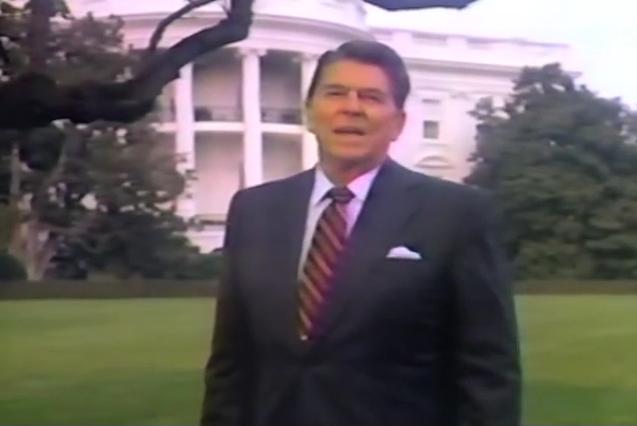
Press play and watch this grand re-run unfold. Watch and learn how these re-run techniques are updated and refined in their delivery. Watch how references made to “drugs” in the 1980s are replaced in sentences with mentions of “borders” and “ISIS.” Listen to the terse, bland sentence structures of the featured speakers -- not just Trump, but everyone -- and the glib, neutered veneer of their voices; as if they were selling products on the QVC Network, or asking questions of contestants on The Price Is Right. Listen to the vocal inflection and emphasis on (and repetition of) the name “Jesus Christ” -- over and over and over again as if we are watching an episode of The 700 Club on the Christian Broadcasting Network, as opposed to sitting inside the Kennedy Center for the Performing Arts -- a public, government institution funded via a unique public-private partnership. Listen to how the names of George Washington and Abraham Lincoln are uttered in close proximity to Jesus Christ in sentence after sentence. Songs praising various branches of the armed forces are preceded and followed by songs praising the power inherent to the name Jesus Christ. In the midst of the Black Lives Matter movement, and in the wake of increased visibility of African-Americans shot by police in the United States -- it is surreal to see an African-American singer belt out lines proclaiming -- “there is an army rising up” -- then joined by the chorus in a refrain of “break every chain” with such rapture, until the entire, multi-ethnic audience rises to sing along. All this in the service of a pesudo-Christian/pro-military context praising the military, law enforcement, and the Trump administration.
Watch and listen at the 52:00 mark to how President Trump actually describes the music and songs he has been listening to. (I would think this would be of interest to those of us working in the arts.) Listen to how preachers and politicians quote Trump’s own tweets and how they bathe his tweets in a beautiful, holy light. Watch the ultra-cheesy rendition of Woody Guthrie’s “This Land Is Your Land” -- the surreal detachment between this performance and the song’s original intention. Behold the rhythmic, stilted waving of American flags by the audience. One can see now why Trump’s recent February 2018 suggestion of presenting a military parade for American armed forces -- seems like a good idea to him. Based on the Celebrate Freedom Rally and Concert -- thousands, if not millions, would happily attend such a parade. Observe the strange, scrolling ticker at the bottom of the screen that reads: “We are an American outlet run by Americans in the USA.” Check out the hair style of the choir leader, Dr. Doran Bugg, and imagine the time he invests each morning on hair products to maintain such perfect elevation. Take a moment, make a few clicks of the mouse, read his official bio on the First Baptist Dallas website; the extreme brevity, devoid of all complexity. Check out the travel blogs of Celebration Concert Tours International around this time period (June-July 2017) -- the photos and comments documenting the days around the Celebrate Freedom Rally and Concert. The way employees of Celebrate Concert Tours International can at one moment -- post about how they’re taking in monuments celebrating the accomplishments of Thomas Jefferson, Abraham Lincoln, and Franklin D. Roosevelt -- but in the next moment earn their paychecks by staging an event for the likes of Robert Jeffers, Louis Gohmert, and Donald Trump. The latter all working to demonize the life’s work of these presidents, which form the basic tenants of government and public service.
And finally -- tragically -- invest a few moments to view the facial expressions of the two young women playing cello during the Celebrate Freedom Concert. If you find the correct clip online, you can clearly see their faces at stage-right when Donald Trump enters and exits the stage. One cellist is a young woman with blonde hair, and the other cellist seated next to her, is a young Asian-American woman. Their eyes are clearly focused on Trump -- just like everyone else in the choir and orchestra -- but neither young woman appears happy. In their faces, we see expressed an awareness of what Donald Trump represents. Reading their body language -- it is clear that neither young cellist wants to be there sharing the same stage with him; let alone playing music to honor him. The total “death-stare” the young blonde woman aims at Donald Trump’s direction as he passes is chilling. Based upon the looks her Asian-American colleague shoots her, one wonders if the young cellist was planning some kind of protest or statement. Each cellist looks miserable in the midst of all this fervent joy and religious zeal. One wonders if they are in the First Baptist Church Orchestra because it is the only good-paying job cellists can find for their art in the Dallas, Texas region.
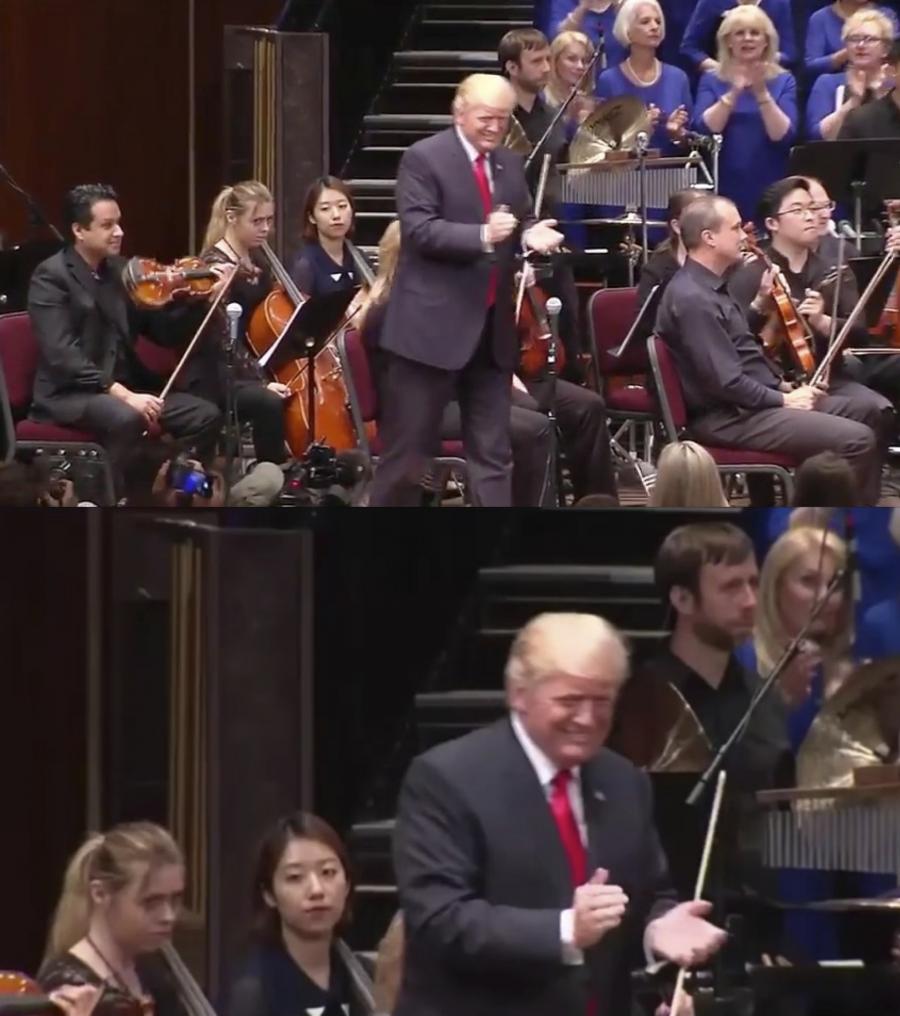
I wonder if my pointing them out will lead to them losing their jobs. I can’t imagine what it must have been like in their hotel room the night before the performance -- agonizing over what they are about to participate in. Did they have anyone in their profession to ask advice or guidance? Is this what they envisioned during all the long years of practice to master their musical instrument? It is heartbreaking to see their expressions. These young cellists seem to possess an awareness lacking in the rest of their colleagues. How alone they must have felt onstage in the concert hall of the Kennedy Center for the Performing Arts -- what was intended to be our national cultural center. How did they even make it through the performance of each song? What did they talk about after it was all over back in their hotel rooms? Where are they now? Are they still employed? Has anyone thought to ask them what their impressions were of the Celebrate Freedom Concert? The answer is obviously “no” -- because if anyone in the arts and entertainment sectors watched the entire rally and concert -- it was probably just an intern -- ordered by producers or editors at The Daily Show, Full Frontal, Last Week Tonight, The Tonight Show, Late Night, Saturday Night Live, Real Time, The Late Show, or -- [ insert another name here ] -- to flag any possible satirical material, then log it, and archive it for future use.
Ultimately, nothing was deemed that outrageous or humorous, and so the entire Celebrate Freedom Rally and Concert came and went without any real notice or discussion. This is a remarkable feat -- even in the dark days of an entrenched Trump administration and total Republican domination of government. A cultural and artistic coup d'état took place in full view on the main concert stage at the Kennedy Center for the Performing Arts -- and no one cares. There were no posts and comment chains on Facebook or Twitter; nor were there any essays on HowlRound or Arts Journal. There were no Op-Eds in any newspapers about what this all might signify for the arts in America -- or what it might portend for future battles over the public funding of the arts and humanities. There was no statement from the Congressional Arts Caucus and -- as far as I can tell -- there was no mention or discussion of it by anyone that I know personally or professionally working in the American arts sector. Judging by the silence, one could infer that the Celebrate Freedom Rally and Concert never happened. But it did. It did happen. And like some science-fiction movie where everyone is replaced by aliens once they fall asleep -- or how an astronaut arrives back to a planet Earth where everything and everyone looks the same, only to discover he has landed in a different reality -- the artistic and cultural coup d'état took place without firing a single shot. It was a bloodless coup d'état that has left all the personnel in place and all the buildings intact -- but is now all taking place within a completely alternate dimension.
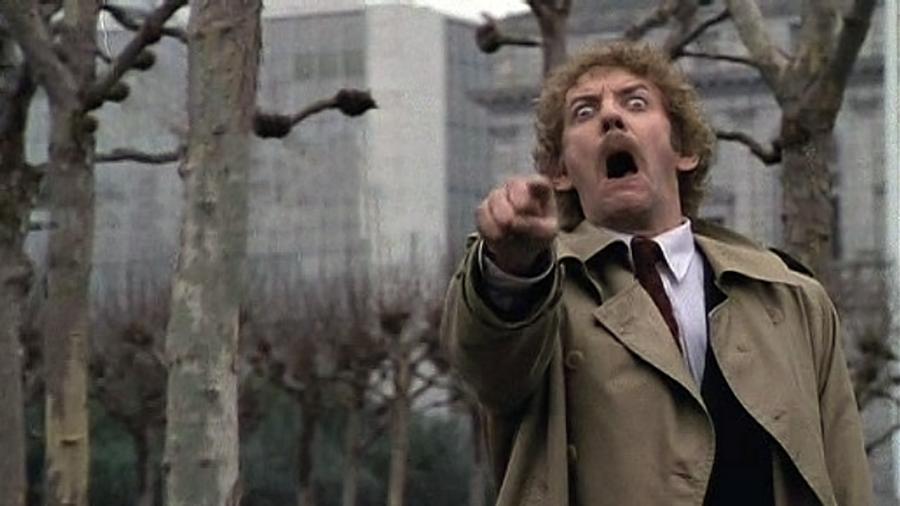
And now for the drum roll, please. Time to bring this train into the station.
I have invoked them at several moments during this essay, so it now appears an appropriate time to finally demand an answer to the question -- where were our artistic and cultural leaders on July 1, 2017?
Did we witness a coup d'etat at the Kennedy Center?
If a coup d'état of the artistic and cultural realm took place -- either literally, or even symbolically, or just plain figuratively -- what did arts leaders and leading artists have to say about it? To recap -- our national cultural center hosted a sold-out concert event that was attended by a man -- sorry, not just anyone, but our President -- who again in 2018 -- has publicly pledged to eliminate all federal funding not just for the actual, physical building he was standing in -- but for all funding of the arts, the humanities, and public broadcasting. What did American arts leaders have to say about it? Did Jane Chu, chairman of the National Endowment for the Arts, have any comment? Or did Deborah Rutter, president of the Kennedy Center? Were there any public comments issued by the heads of any State Arts Councils around the nation? Did the Kennedy family issue a statement? What did leading American artists, actors, musicians, or writers say in reaction to the first occasion (in an official capacity) of President Trump setting foot inside what is supposed to be hallowed ground? There was plenty to say and satirize, to blog and post about, later on that year in December surrounding President Trump’s decision not to appear at the 2017 Kennedy Center Honors ceremony. There was so much to say when Trump did not appear inside the building. What did we in the arts and entertainment sectors say when Trump did appear at the Kennedy Center five months earlier?
The answer is not a pretty one. We didn’t say anything at all. Nothing. Not in protest, or even in jest. Nothing was said about the matter. It’s not like we weren’t talking, it’s not like we weren’t posting. We were. We always are. Just not about this. Instead -- those of us working in the arts were talking about our frequent flier miles.
Yes, you read that correctly. American artists and arts leaders had just concluded 2.5 weeks of endless debate about their frequent flier miles. It was an intense debate, a hot summer was underway, and it was the official start of a long holiday weekend -- so it’s understandable if American artists and arts leaders were tired by the time July 1st rolled around. As any experienced traveler can tell you, fighting over your frequent flier miles can be an exhaustive and draining experience. It’s understandable if American artists and arts leaders missed Trump’s first (and only) Kennedy Center appearance. Right? I mean, it’s understandable, right? It’s understandable.
American artists and arts leaders had spent the bulk of the preceding weeks of June 2017, locked in a reactive debate over the “furor” that erupted in New York City from the Public Theater’s production of Julius Caesar by William Shakespeare. It was presented as part of their annual summer Shakespeare In The Park programming at the Delacorte Theatre in Central Park. The production -- directed by the Public Theater’s artistic head, Oskar Eustis -- was a faithful interpretation of Shakespeare’s play. It featured the title character of Julius Caesar played by blonde-haired, 60s-something actor, Gregg Henry; who bears an uncanny resemblance to President Trump. His casting was aided by additional costume choices like Trump’s slightly baggy suits and his trademark, solid-colored ties that extend below his waist.
To drive home the point even more clearly, the character of Calpurnia, Caesar’s wife, was played by actor Tina Benko; who struts around stage like a supermodel and spoke with what sounded like a slight Slovenian accent (aka, First Lady Melania Trump). Needless to say, when the inevitable assassination of Julius Caesar by Cassius, Brutus, and other conspirators is depicted on stage in a graphic manner -- some in the audience inferred it as advocating the assassination of President Trump. Tabloids in New York City picked up the story, which was followed by an indignant (yet misguided) tweet from Donald Trump Jr. complaining about the NEA (who did not fund the production). Once Fox News got in on the act and fueled the controversy even further -- it was off to the races. Two of the Public Theater’s main corporate sponsors of Shakespeare In The Park programming -- the Bank of America and Delta Airlines -- promptly revoked their financial support and issued strong public statements condemning the Public Theater’s production. What followed was several weeks of debate over free speech, corporate sponsorship, and artistic freedom.
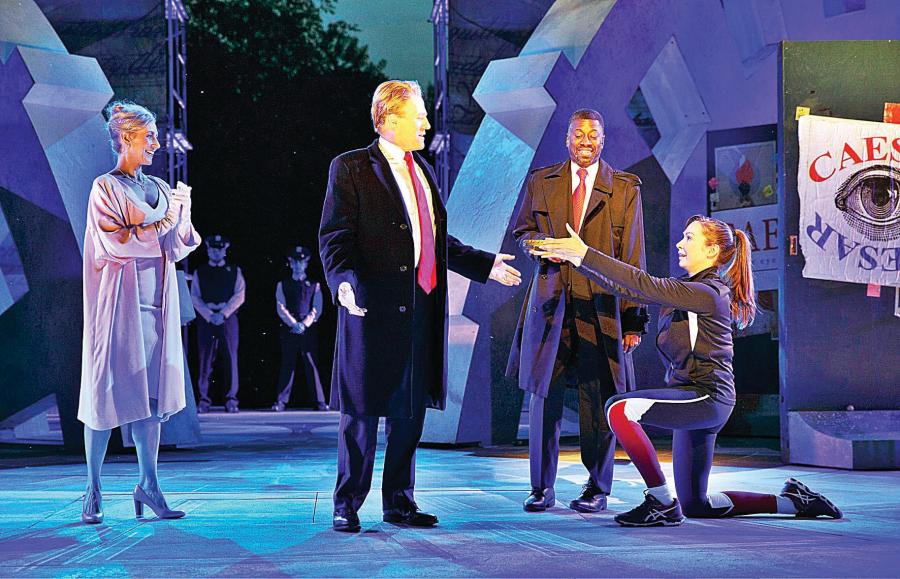
Delta Airlines’ decision to revoke sponsorship support quickly evolved into the cause célèbre of American artists and arts leaders working in the entertainment industries and performing arts sectors. The Julius Caesar production dominated the American news cycle during June 2017 -- from the Los Angeles Times to TIME Magazine -- even making waves into prime-time coverage on ABC, CBS, and CNN; a rare occurrence for American theatre. It sparked multiple Op-Ed pieces across the country and became “The Defining Social Media Thing” to post, tweet, and talk about -- (for a few weeks, at least). Because no one in their right mind would still have a bank account with the evil “financial crisis-inducing” Bank of America -- artists, presenters, and arts leaders coalesced their complaints around Delta Airlines. And because most people working in the entertainment and performing arts sectors have to travel for work and/or touring -- the subject of their complaints to Delta Airlines rallied around a single, cherished commodity -- our frequent flier miles (or as Delta Airlines refers to their company loyalty program -- Skymiles.)
Slacktivism?
If you worked in the arts in New York City, you were duty-bound to sign the inevitable MoveOn.org petition which circulated -- (now at a whopping 1,020 signatures). If you were a Delta Skymiles member -- (which, in full disclosure, I am) -- you adopted the “Customer Service Letter” template that made the rounds online. You dutifully submitted your letter of complaint to Delta Airlines concerning their “censorship;” being sure to include the obligatory consumer threat of “taking your business elsewhere.” Debates on “artistic free expression” and “corporate censorship” sprung up on Twitter threads, Facebook feeds, and in the comment sections of news articles and Youtube videos all over social media. Heated discussions took place on which replacement airlines might better serve artists. Later on that June, a small rally to protest “corporate censorship” was held at Astor Place in New York City, around the corner from the Public Theater. By the end of June 2017, the controversy died down -- as most brushfire “arts-related” controversies usually do. The documentary filmmaker, Michael Moore, had the final word by donating $10,000 to the Public Theater to help off-set the loss of corporate funding. Whether Delta Airlines ever responded to their individual customers’ letters of complaint -- or if Skymiles members working in the arts and entertainment sectors followed through on their threatened boycott -- is, to date, unknown.
The Public Theater / Delta Airlines controversy can be viewed as a debacle for the concept of public funding for the arts and culture in the United States. It provides evidence that the nation’s artistic and cultural leadership is poorly equipped to respond to the mortal threats posed by a Trump administration. The play selection and the casting/staging decisions by the Public Theater’s artistic director, Oskar Eustis, serves as a clear indicator that if any so-called “political” art emerges in an “Age of Trumpism” -- it shall amount to nothing more than a four year re-run of the obvious “George Bush Is Bad!! / Dick Cheney Is Bad!! / Donald Rumsfeld Is Bad!!” aesthetic that dominated American theatre from 2002-2008. The direct and linear “low-hanging fruit” the Julius Caesar production pursues -- indicates that our mainstream arts institutions shall not conduct any complex examination of the underlying structures and ongoing mechanics which contribute not only to the current, desperate state of the arts in America -- but to the actual reasons why Trump was over-looked and under-estimated to win election in the first place. The Public Theater walked headlong into an obvious controversy so tailor-made to fit the long-term strategy of the Republican Party and the neatly-manicured cycles of Fox News talking points. It is akin to the DNC nominating Chelsea Clinton for President in the 2020 election cycle.
After nearly 30 years of Republicans employing the same identical and predictable tactics -- American arts leaders cannot offer up any comprehensive strategy for a successful counter-attack to reclaim lost ground for the arts in the public realm. The entire Public Theater/Delta Airlines controversy operates from the same weakened position -- arts professionals on the defensive -- reacting and responding to attacks and criticism. We are incapable of playing offense. We are incapable of proactively communicating to the American people the great narrative embedded within the story of public funding for the arts and culture. The actual legislation that created the National Endowment for the Arts and Humanities is filled with bold, original, and poetic language -- a rarity in American federal law. It is an empowering document; filled with vocabulary words tailor-made for a successful game plan on offense. It is an enabling document -- that similar to the Civil Rights Act of 1964 passed the previous year -- demands to be revisited again and again. Not simply in a defensive maneuver, but to achieve even greater artistic and cultural rights for the American people. It is very possible to increase the operating budgets of the NEA and NEH to reach even more artists and citizens. And guess what? Nobody has to do anything new -- because it is the law! The law is still on the books. The NEA/NEH legislation is the law of the land and has been since 1965.
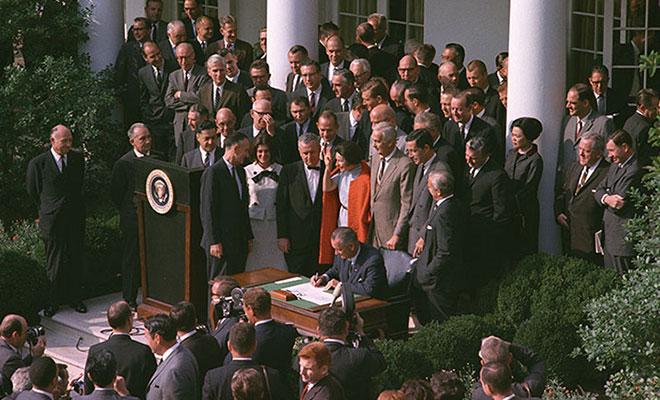
A series of interconnected delusions
Our inability to realize this, our unwillingness to achieve this -- stems from widespread misconceptions and a conflation of terms. There is a great paradox afoot in the American arts landscape. Our inability to address it is not an accident. The Public Theater/Delta Airlines controversy pulls back the curtain to reveal that leading artists and arts leaders tend to operate within “a series of interconnected delusions” (to quote the late Neil Postman). One delusion equates Delta’s withdrawal of corporate sponsorship to the censorship of artistic freedom. This is incorrect. The First Amendment does not provide any protection against “corporate censorship” and corporate sponsorship in the arts is a contractual relationship -- that like any business agreement -- can be terminated at any time. Consider the sheer tenuous nature of such relationships and their prevalence across the American arts landscape.
A second delusion is that this debate is taking place within the public realm. It is not. The discussion is taking place within a closed loop -- operating elsewhere -- beyond the reach of the general public. I don’t know about you, but I’m a native New Yorker -- I’ve been everywhere from the old Surf Reality to the Metropolitan Opera -- from the Brooklyn Academy of Music to JACK and the Bushwick Starr -- and I’ve never been able to get tickets for Shakespeare In The Park. They’re about as exclusive a ticket as court-side seats for a New York Knicks game, or box seats behind home plate at Yankee Stadium. Neither exists for regular people anymore. They are accessible only to the wealthy, to corporations -- and to those who maintain close connections with either. It is disingenuous to describe Shakespeare In The Park as serving the general public. On the contrary, their audience is comprised of insiders with connections to mainstream television and film corporations; the commercial “for-profit” Broadway industry; and the dominant Wall Street / Health Care / Lifestyle / Advertising / Higher Education sectors in New York City. [ Ironically, the same demographics who create and maintain, or digest, the “Derision & Disgust” industries mentioned earlier. ] The insular responses one saw playing out across social media during June 2017 reflects a disconnect from the realities and concerns of most, working Americans. Can arts leaders and prominent artists conceive of just how unfathomable a privilege it is to even be capable of protesting with frequent flier miles? The general public does not share in our manufactured outrage -- because in our quest for high-level donors and corporate sponsors, we have abandoned any attempt to involve the general public. As is often the case in America since the mid-1990s -- whenever artists, arts groups, or arts institutions face sudden budget cuts or total elimination -- the general public is mostly absent. The street protesters and petition signatories are comprised only of artists, arts workers, and arts leaders. The general public is lost, confused, and barely surviving in what is left of America’s endless post-Great Recession landscape.
A third delusion operates from the belief that great strides were made in the public funding of the arts and culture during the Obama years. This is a delicate issue to navigate. There is no doubt that the National Endowments for the Arts and the Humanities have funded an impressive amount of artistic and cultural projects. From 2009-2016, both agencies made a profound impact in communities all across the United States. Prior to attacks mounted in the late 1980s, the NEA was factually graded as one of the most successful government programs of all time; and by all accounts, it remains that way. In the midst of unfair attacks and budget cuts during the 1990s, the NEA staff continued their impressive work and maintained that high success rate through both Republican and Democratic administrations. However, large segments of the American arts establishment -- weary of the disruptive, endless rounds of arts brushfires -- abandoned the public realm for the safer terrain of the private sector; embarking upon an endless pursuit of an emergent private donor class, created from “bubble wealth” of the late-1990s and opening decades of the 21st century. Similar to the illusion of progress the Obama administration concocted in its dealings with the financial industries and the health care industries -- the lack of a bold, counter-attack to reclaim lost terrain has exposed the public funding of the arts in America to a vicious flanking maneuver from The Right. The endgame is now upon us.
While the Obama appointments of a commercial, “for-profit” theatre producer (Rocco Landesman, 2009-2012) and a veteran arts manager with fundraising expertise (Jane Chu, 2014-2018) -- might have avoided controversy during their nomination process in Congress -- each has presided over shifts in the field at the molecular level. These shifts involve changes to language and vocabulary. When extrapolated out from Washington, D.C. to the non-profit arts sector across the nation -- these shifts have seen the original, bold narratives for public funding of the arts wither at the roots, until they are mere shadows of their former selves. Eight-plus years of increased emphasis upon “market-values” vocabularies, and “economic impact” justifications, and “job creator” arguments -- represents a far cry from the original yet simple language of American arts legislation.
The outrage does not manifest itself in a public space with public impact. Rather, the entire exercise takes place on Twitter, or on Facebook -- in the private realms of wealthy corporations to simply critique other wealthy corporations.
The American arts sector has spent much of the last few decades back-peddling in retreat from successful Republican attacks that crystallized in 1995-1996; when the NEA was nearly eliminated and its budget brutally slashed nearly in half. For two decades, it took comfort in newly invented language like -- “the Creative Class” and “Vibrancy” and “Creative Placemaking” -- to serve as simulalcra in place of language that might be unearthed in FDR’s The New Deal, or LBJ’s The Great Society. Reading a speech from an NEA chairman these days is like reading the dense text of the Dodd-Frank Wall Street Reform Act or the Affordable Care Act; both impenetrable texts authored primarily by lobbyists and technocrats. An entire generation of arts managers and artists have now grown up to become leaders in their field -- without any knowledge of the original vocabulary employed to argue the public funding of the arts into existence in the first place. (This is the realization of a dystopian nightmare the late theatre scholar Dragan Klaić envisioned in the “Preface” to his deathbed book, Resetting The Stage: Public Theatre Between the Market and Democracy.) Vanished from our contemporary vernacular are the bold arguments of President John F. Kennedy and Senator Claiborne Pell. During the Bush and Obama years, the contemporary arts establishment convinced itself of the delusion it had no further need for them. Gone are the impassioned defenses mounted by former NEA Chairs John Frohnmayer (1989-1992) or Bill Ivey (1998-2001). They have been displaced and replaced with a simulacrum of a public arts funding system -- one based upon appeals to gross domestic product, job creation, and savvy urban design planning.
Even the legendary performance artist, Karen Finley, has been terraformed into a simulacrum of her former self. At the outset of the Trump administration, Finley attempted one of the earliest public defenses of the National Endowment for the Arts. She deserves credit for not entertaining any whimseys that President Trump might differ from Candidate Trump. She knew full well that the NEA, NEH, and PBS would be the first targets lined up in his crosshairs. However, similar to delusions expressed in the great Delta Skymiles Defense -- Finley’s arguments did not evolve beyond appeals to property values and decorations.
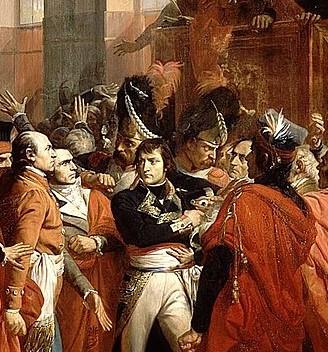
When President Trump stepped into the John F. Kennedy Center for the Performing Arts on July 1, 2017 -- the coup d'état ushered in under his footsteps had been transpiring for years. This coup d'état was made all the more swift and easy -- because there was no resistance. A coup d'état of the artistic and cultural realm of our nation was possible because our artistic leaders were operating in some “elsewhere” realm, some “elsewhere” space, speaking in the veneer of some “elsewhere” discourse. I don’t really know where this “elsewhere” place is -- I will leave that up to those who employ “elsewhere” language to locate it on a map. What is made painfully clear by the lack of reaction to the events of July 1, 2017 -- is that the coup d'état itself does not even matter anymore. The coup d'état does not matter, because there is no one there. There is no one left in the public space, occupying the public realm, speaking for the public’s benefit. This terrain was yielded years ago. Former NEA Chair, John Frohnmayer, warned us of this back in 1992. He identified attacks on the arts during his tenure, as canaries in the coal mine of our national life. The “redefinition of the social contract for our generation” is now complete. Future contracts will be issued to the American people -- and to its artists -- but they will be written on terraformed paper with terraformed ink.
All the usual events will still happen -- like the Kennedy Center Honors ceremony -- but they will take place within a simulacrum of a national cultural center. Prominent artists and pundits made so much fuss when President Trump did not attend the December event celebrating Lionel Richie, Norman Lear, LL Cool J, Carmen de Lavallade, and Gloria Estafan. What did not occur to anyone, was the possibility that Trump did not need to attend, because his task was accomplished five months earlier at the Celebrate Freedom Rally and Concert. President Trump (and those who surround him) has no further need for the John F. Kennedy Center for the Performing Arts -- because he already usurped it. In the same trademark, prescient style he displayed during the 2016 election cycle -- Trump knows that a shift has taken place in American arts and culture. Barring anything but an all-out counter-attack by American artists, American arts leaders -- and most importantly, American citizens themselves -- to reclaim this lost terrain and hold this public ground -- the Kennedy Center coup d'état will thicken and congeal to merge with all the other public institutions Trump has solidified around him.
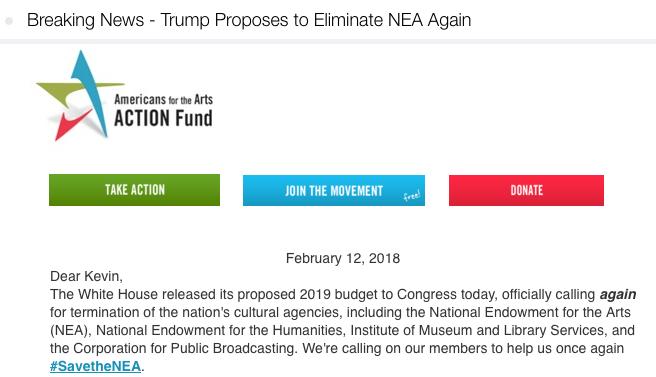
We must save the NEA again. And again. And again.
The e-mails have already commenced. They started to arrive in your inboxes during February 2018, after Trump announced his new budget for fiscal year 2019. They bear the same subject headers and identical content as the e-mails that arrived during the same month last year. It’s time to save the NEA again. Yes, we must now all assemble like The Avengers to save the NEA. In many respects, these e-mails repeat themselves the same way their distant cousin e-mails repeat themselves after each mass gun shooting in America. There is no need to modify the layout or template. Probably there is a great deal of copy-and-paste. Yes, the time has arrived to save the NEA. Until the next time, and then we must save the NEA again. And then save the NEA yet again -- year after year, year after year -- always responding to the enemy’s initiative, never investing the time in formulating some other strategy. As if no one could have foreseen such a predictable array of tactics. Yes, it’s time to save the NEA. We must save the NEA again. And then save the NEA yet again. And then save the NEA once more, one last time. We must save the NEA again.
What those of us working in the arts do not comprehend -- is that with each new round of “NEA saving” -- something gets picked up and shifted in America. Something gets shifted, but not in a positive direction; it is not an affirming course of action. Something gets picked up by that vast contradiction behemoth sauntering across our landscape, and deposits the whole endeavor further down the road in a location it prefers; beyond our view. This shift has transpired in so many other aspects of American society. It is like responding to that Chrysler-Dodge RAM Trucks commercial that aired during the 2018 Super Bowl -- the one which appropriated speeches of Dr. Martin Luther King Jr. to sell a brand new line of pick-up trucks.
The outrage does not manifest itself in a public space with public impact. Rather, the entire exercise takes place on Twitter, or on Facebook -- in the private realms of wealthy corporations to simply critique other wealthy corporations. This is not what democracy looks like. It is the sound of money speaking to money. It enchants itself with itself. Clever enough to make itself indistinguishable from what has come before, it enchants itself with itself. Swirling and swirling with each new shift. It enchants itself with itself. Fundraisers will be held. Swirling and swirling. Donors will be courted. It enchants itself with itself. Celebrities will be posed with; selfies will be taken. Swirling and swirling. Guests of honor will be invited to benefits; where they shall be duly honored. It enchants itself with itself. Swirling and swirling like the early moments of Edvard Grieg’s “In the Hall of the Mountain King” -- it enchants itself with itself, swirling and swirling -- but never evolving to reach that heightened crescendo -- it remains fully content to swirl and swirl, to enchant itself with itself. The best all of us can hope for -- is a break from a rotation or two -- in order to relax for awhile and redeem our Skymiles.
-- Kevin Doyle (February 16, 2018)
This essay was derived from work and ideas developed for THE AЯTS project under a 2017 IMPACT Residency Award at the Laguardia Performing Arts Center (New York), a Saari Residence Fellowship at the Kone Foundation (Finland), and a Cultural Exchange Fund Award from the Association of Performing Arts Presenters / Andrew W. Mellon Foundation – and for the lecture-performance PMURT presented on May 23, 2017 at the Vooruit Arts Center (Gent, Belgium) and on May 11, 2018 at Dixon Place (New York), with additional support during 2016-2017 from Arc (Switzerland), the Jentel Foundation (Wyoming), the Regina Barnes Fellowship at the Mesa Refuge (California), the PEN America Writers' Emergency Fund (New York), a Kesselring Grant from the Dramatists Guild Fund (New York), and Hill House at the Crosshatch Center for Art & Ecology (Michigan). The essay was written during February 2018 at the Escape To Create artist residency program in Seaside, Florida.
For Katey Parker.